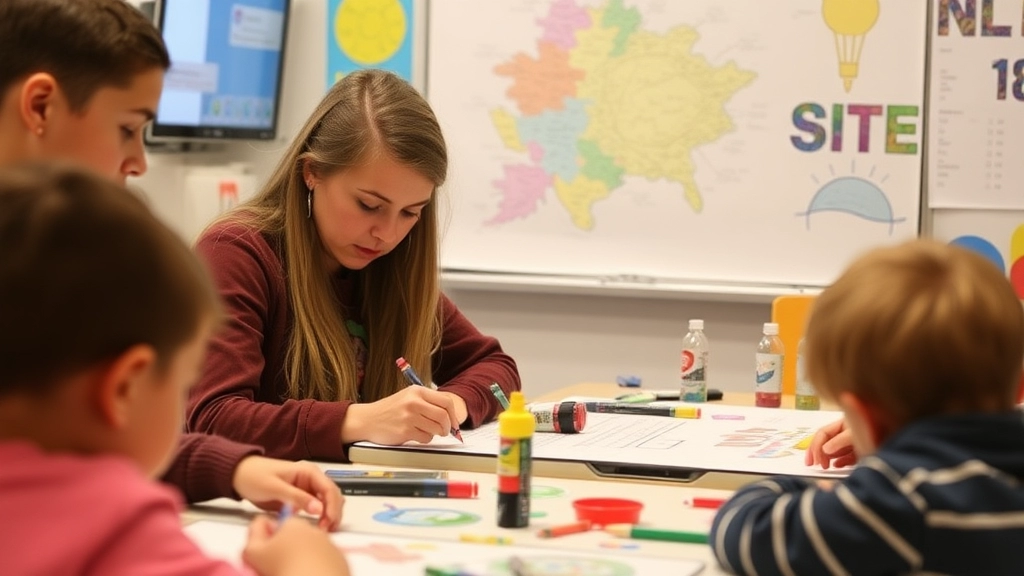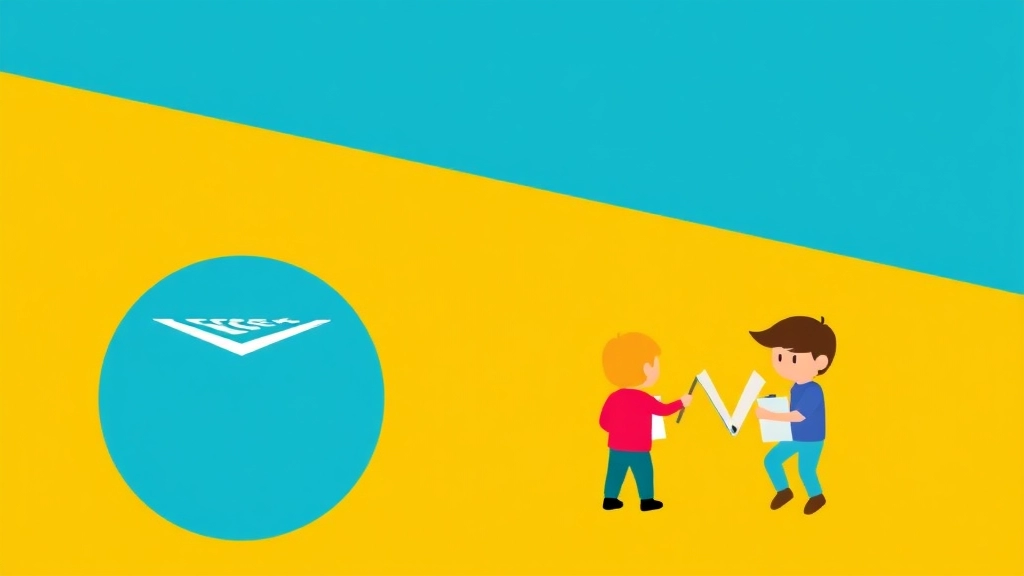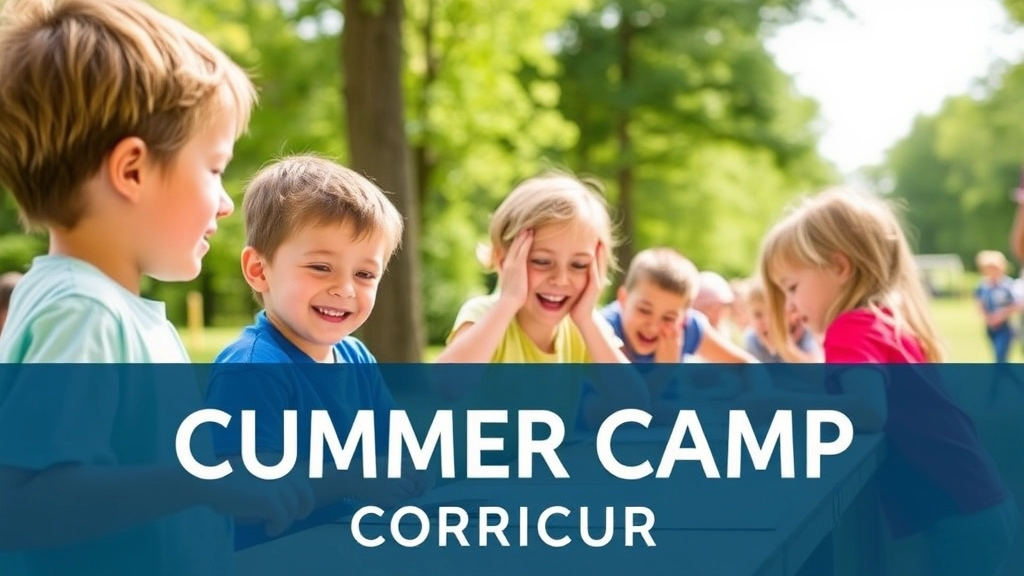Creating an Engaging Summer Camp Curriculum
Creating an engaging summer camp curriculum is an art that combines fun, learning, and safety. This article delves into the intricacies of designing a program that captures children’s imaginations while meeting parents’ expectations. From understanding the basics to setting clear goals, structuring daily schedules, and involving kids in planning, we cover every essential aspect.
Key Components of Successful Programs
We explore key components of successful programs, including:
- Age-appropriate activities
- The integration of STEM and creative arts
- The importance of outdoor and adventure-based learning
Customization and Safety
Customizing the curriculum for special interests, ensuring safety and supervision, and continuously evaluating and improving camp programs are also highlighted. Dive in to discover how to create a summer camp curriculum that kids love and parents trust.
Designing an Engaging Summer Camp Curriculum
Alright, let’s dive into the nitty-gritty of designing an engaging summer camp curriculum. You’re probably wondering, âHow do I create a summer camp that kids love and parents trust?â Well, let’s break it down step-by-step.
Understanding the Basics
First off, summer camp curriculumâit’s not just a fancy term. It’s the backbone of your camp. It’s what keeps kids excited and coming back year after year. So, what’s your starting point? Think about:
- What do kids enjoy? Adventure, creativity, learning new skills?
- What do parents value? Safety, educational value, personal growth?
Setting Clear Goals
You need a roadmap. What do you want the kids to achieve by the end of the camp? Here are some ideas:
- Skill development: Whether it’s learning to swim, coding, or painting, set specific skills kids can pick up.
- Social skills: Encourage teamwork, leadership, and communication.
- Confidence: Activities that push kids out of their comfort zones in a supportive environment.
Structuring the Daily Schedule
A solid structure is crucial. Kids thrive on routine, even during the summer. Here’s a rough outline:
- Morning: Start with something energetic to wake them upâthink team sports or dance-offs.
- Mid-morning: Transition into educational activities like STEM projects or creative arts.
- Lunch: A well-deserved break with nutritious food.
- Afternoon: Outdoor adventures or field trips.
- Late afternoon: Wind down with quieter activities like storytelling or crafts.
Flexibility is Key
While structure is important, flexibility is your best friend. Be ready to pivot based on the kids’ interests and energy levels. If they’re super into a particular activity, let them run with it.
Involving the Kids
Kids love having a say in what they do. So, involve them in the planning:
- Surveys: Simple questionnaires on what activities they want.
- Suggestion box: A place for kids to drop their ideas.
- Group discussions: Regular check-ins to see what’s working and what’s not.
Keeping it Fresh and Fun
No one wants to do the same thing every day. Mix it up:
- Theme days: Pirate Day, Space Exploration Day, etc.
- Guest speakers: Invite local heroes, artists, or scientists.
- Special events: Talent shows, scavenger hunts, or mini-Olympics.
Real-Life Example
Remember that one summer camp where the kids built a life-sized cardboard castle? Not only did they learn about engineering and teamwork, but they also had a blast doing it. That’s the kind of memorable experience you want to create.
Key Components of a Successful Program

Ever wondered what makes a summer camp program truly successful?
I get it, you want to create an experience that kids will remember for a lifetime.
So, let’s break it down.
Clear Objectives and Goals
First things first, you need clear objectives.
What do you want the kids to learn?
Whether it’s teamwork, leadership, or new skills, having clear goals is essential.
Engaging Activities
Next up, engaging activities.
Kids get bored easily, right?
So, mix it up.
Incorporate a variety of activities:
- Sports and Games: Keeps them active and healthy.
- Arts and Crafts: Unleashes their creativity.
- STEM Projects: Engages their minds.
Qualified Staff
You can’t run a successful camp without a great team.
Your staff should be:
- Qualified: They need the right skills and experience.
- Passionate: They should love working with kids.
- Attentive: Safety first, always.
Safety Measures
Speaking of safety, it’s non-negotiable.
Ensure you have:
- First Aid Kits: Easily accessible and fully stocked.
- Emergency Plans: Clear procedures for any situation.
- Supervision: Adequate staff-to-child ratios.
Flexibility
No two kids are the same.
A successful program is flexible enough to cater to different needs and interests.
Parental Involvement
Keep parents in the loop.
Regular updates and open communication build trust and keep everyone on the same page.
Feedback Loop
Finally, always look for ways to improve.
Gather feedback from:
- Kids: What did they love? What could be better?
- Parents: Any concerns or suggestions?
- Staff: What worked well? What didn’t?
Real Stories
I remember one summer, we had a kid who was super shy.
By the end of the camp, he was leading group activities.
That’s the kind of impact you want.
Age-Appropriate Activities and Learning Goals
Alright, let’s get real for a second. Planning a summer camp curriculum that keeps kids engaged and learning isn’t just about throwing in random activities. You’ve got to hit the sweet spot with age-appropriate activities and learning goals. Trust me, it makes all the difference. So, how do we nail this?
Why Age-Appropriate Activities Matter
Ever tried to get a five-year-old to sit through a lecture on quantum physics? Yeah, not happening. Kids of different ages have different developmental needs, attention spans, and interests. Here’s how to break it down:
- Young Kids (Ages 5-7): These little ones are all about play. They learn best through hands-on activities and games. Think arts and crafts, simple science experiments, and storytelling sessions.
- Tweens (Ages 8-12): This age group is curious and loves challenges. They’re ready for more structured activities like team sports, basic coding, and nature hikes.
- Teens (Ages 13-17): Teenagers crave independence and complex tasks. Offer them leadership workshops, advanced STEM projects, and adventure-based activities like rock climbing.
Setting Learning Goals
Now, let’s talk learning goals. The aim is to keep it fun but educational. Here’s a cheat sheet for setting those goals:
- For Young Kids: Focus on basic skills like sharing, following directions, and basic motor skills. Goals could be as simple as “learn to tie shoelaces” or “understand the concept of teamwork.”
- For Tweens: Aim for intermediate skills such as problem-solving, basic coding, or understanding ecosystems. Goals here might include “complete a group project” or “learn to code a simple game.”
- For Teens: Go for advanced skills like leadership, critical thinking, and advanced STEM concepts. Goals could be “lead a team project” or “design and execute a science experiment.”
Real-Life Examples
Let’s sprinkle in some real-life examples to make this crystal clear. Imagine a camp where:
- Young Kids: Spend the morning making clay animals and the afternoon playing team-building games.
- Tweens: Start the day with a scavenger hunt that teaches them about local flora and fauna, then dive into a basic robotics workshop.
- Teens: Kick off with a leadership seminar followed by a challenging ropes course in the afternoon.
Pro Tips for Camp Leaders
Here are some tips to keep your activities and learning goals on point:
- Mix It Up: Variety keeps kids engaged. Rotate between physical, mental, and creative activities.
- Keep It Interactive: Hands-on activities are a hit across all age groups.
- Get Feedback: Regularly ask campers what they enjoyed and what they didn’t. Use this info to tweak your program.
For more ideas on engaging activities, check out our summer camp activities guide. And if you’re looking to set up a great environment for these activities, don’t miss our tips on top features of summer camp buildings.
Incorporating STEM and Creative Arts

Ever wondered how to make summer camp more than just a fun escape?
How can you blend learning with play so kids don’t even realise they’re getting smarter?
Incorporating STEM and Creative Arts into your summer camp curriculum can be the answer.
Why STEM and Creative Arts?
Let’s break it down:
- STEM (Science, Technology, Engineering, Mathematics): These fields are the building blocks of the future. Kids get hands-on with experiments, coding, and problem-solving.
- Creative Arts: This is where imagination runs wild. Think painting, drama, music, and crafts. It boosts creativity and emotional expression.
How to Integrate STEM and Creative Arts
Themed Weeks
- Space Week: Build rockets, learn about planets, and create galaxy paintings.
- Robotics Week: Design simple robots, program them, and make robot-themed art.
Daily Mix
Morning: STEM Activities
- Science Experiments: Simple, safe, and fun. Think volcanoes and slime.
- Coding Basics: Use kid-friendly platforms like Scratch.
Afternoon: Creative Arts
- Drama Workshops: Act out stories related to the morning’s science lesson.
- Art Projects: Create art inspired by the day’s STEM topic.
Collaborative Projects
- STEM + Art: Build a bridge (engineering) and then decorate it (art).
- Tech + Music: Use apps to create music and then perform it.
Real Stories, Real Impact
I remember a camp where we combined STEM and Creative Arts.
We had a “Build and Paint” day.
Kids built simple wooden structures and then painted them.
One kid, usually shy, turned out to be a fantastic builder.
Another, who struggled with maths, found joy in painting.
Both kids left camp with new skills and confidence.
Why It Works
- Engagement: Kids are more engaged when activities are varied.
- Skill Development: They develop both analytical and creative skills.
- Fun Learning: They learn without feeling like they’re in a classroom.
Quick Tips to Get Started
- Keep it simple: No need for complex projects.
- Use everyday materials: You don’t need fancy equipment.
- Encourage collaboration: Kids learn better together.
Outdoor and Adventure-Based Learning
Ever wondered how to keep kids excited and engaged while they’re away from their screens? Outdoor and adventure-based learning is your answer. Let’s face it, the great outdoors offers a treasure trove of experiences that can’t be replicated indoors. But how do you make sure these activities are both fun and educational? Let’s dive in.
Why Outdoor Learning is a Game-Changer
Kids today are glued to their devices. Getting them outside is a win-win. They get fresh air, exercise, and a break from screen time. Plus, outdoor activities can teach them invaluable life skills. Think about itâwhat better way to learn teamwork, problem-solving, and resilience than through adventure?
Core Benefits of Adventure-Based Learning
- Physical Fitness: Climbing, hiking, and running around keeps kids active.
- Mental Health: Nature has a calming effect, reducing stress and anxiety.
- Teamwork: Group activities like treasure hunts or obstacle courses build camaraderie.
- Problem-Solving: Navigational challenges and survival skills sharpen their minds.
Tried and Tested Outdoor Activities
Here’s a list of activities that have proven to be hits at summer camps:
- Nature Hikes: Teach kids about local flora and fauna while keeping them moving.
- Obstacle Courses: Build physical and mental strength.
- Survival Skills: Basic first aid, building shelters, and finding food in the wild.
- Water Sports: Canoeing, kayaking, and swimming are not just fun but also teach water safety.
- Treasure Hunts: Use maps and clues to find hidden treasures, boosting their problem-solving skills.
How to Plan an Adventure-Based Curriculum
Planning is key. Here’s a quick breakdown:
- Assess Interests: Know what excites your campers. Are they into water sports or more into hiking?
- Safety First: Always have a risk assessment for each activity.
- Skill Levels: Cater activities to different skill levels. Not everyone will be an expert climber.
- Instructors: Make sure you have trained professionals for specialised activities like rock climbing or kayaking.
- Equipment: Ensure you have all the necessary gear and it’s in good condition.
Safety Measures and Supervision
Safety can’t be overstated. Here’s how to keep things secure:
- Buddy System: Always pair kids up. No one goes anywhere alone.
- First Aid Kits: Have multiple kits accessible at all times.
- Certified Instructors: Ensure all activities are overseen by certified professionals.
- Emergency Plans: Clear protocols for emergencies should be in place and communicated to all staff and campers.
Real-Life Example: The Impact of Outdoor Learning
Let me share a quick story. At one of our camps, we had a shy kid named Jake. He was hesitant about joining the nature hike. But by the end of the week, he was leading the group, pointing out different plants and animals. His confidence soared, and his parents couldn’t believe the transformation. That’s the power of outdoor learning.
For more ideas on keeping your camp engaging, check out our Summer Camp Activity Ideas for Endless Fun and learn how to Host the Ultimate Summer Camp Party Bash.
Customising Curriculum for Special Interests

Ever worried about keeping every kid engaged at summer camp?
You’re not alone.
One size doesn’t fit all when it comes to kids’ interests.
That’s where customisation comes in.
Why Customise?
Kids are unique.
They’ve got their own passions and quirks.
Customising the curriculum means:
- Higher engagement: Kids are more likely to participate.
- Better learning: They’ll absorb more when they’re interested.
- Happier campers: They’ll have more fun, simple as that.
How to Customise
First, know your campers.
Ask them what they like.
Send out surveys to parents before camp starts.
Get a feel for what excites them.
Once you’ve got that info, you can start tailoring the activities.
Steps to Customisation
- Identify Interests
- Sports: Football, basketball, swimming
- Arts: Painting, drama, music
- STEM: Robotics, coding, science experiments
- Nature: Hiking, bird watching, gardening
- Create Special Interest Groups
- Divide kids into groups based on their interests.
- Rotate groups to give them a taste of everything.
- Develop Specialised Activities
- Sports: Organise mini-tournaments.
- Arts: Host an art show or a play.
- STEM: Build a robot or conduct a cool experiment.
- Nature: Plan a scavenger hunt or a nature walk.
- Bring in Experts
- Hire specialists or invite guest speakers.
- Think local artists, scientists, or athletes.
Real-Life Example
Last summer, we had a kid named Jake.
He was mad about dinosaurs.
So, we created a mini dino-dig activity.
Jake was thrilled.
And guess what?
Other kids loved it too.
Customisation can turn a good camp into a great one.
Safety and Supervision in Camp Activities
Worried about keeping kids safe at summer camp? Yeah, I get it. Safety is a big deal, and if you’re running a camp, it’s the number one priority. So, how do we nail safety and supervision without turning the whole thing into a snooze fest? Let’s break it down.
Why Safety Matters
First off, let’s talk about why safety is crucial. No parent wants to send their kid to a camp where they might get hurt or lost. And trust me, no camp director wants that on their watch either. It’s not just about avoiding accidents; it’s about creating an environment where kids can thrive and parents can relax.
Key Elements of Effective Supervision
Alright, so how do we make sure every kid is safe while still having a blast? Here are some key elements:
- Staff Training: Every staff member should be trained in first aid, CPR, and emergency procedures. They should know the camp layout like the back of their hand.
- Ratio of Staff to Kids: Keep the ratios tight. For younger kids, you might need more staff. For older kids, you can loosen it up a bit, but always make sure there’s enough supervision.
- Clear Rules and Guidelines: Make sure everyone knows the rules. And I mean everyoneâstaff, kids, and even parents. Clear guidelines help prevent accidents before they happen.
- Regular Headcounts: This might sound basic, but regular headcounts are a must. Know where every kid is at all times.
Real-Life Example
Let me share a quick story. At one of the camps I ran, we had a kid who wandered off during a nature hike. Panic mode, right? But because we had regular headcounts and walkie-talkies, we found him in minutes. No harm done, and it was a wake-up call to tighten our procedures even more.
Outdoor Activities: High Stakes, High Fun
Outdoor activities are a staple of any good summer camp, but they come with their own set of risks. Here’s how to keep things safe:
- Risk Assessments: Before any activity, do a risk assessment. Know the potential dangers and how to mitigate them.
- Safety Gear: Helmets, life vests, harnessesâdon’t skimp on the gear. It’s better to be over-prepared.
- Buddy System: Pair kids up. They look out for each other, and it makes supervision easier.
- Emergency Plans: Have a clear plan for emergencies. Everyone should know the drill, from staff to campers.
Indoor Activities: Don’t Let Your Guard Down
Indoor activities might seem safer, but they come with their own challenges:
- Safe Spaces: Make sure indoor spaces are free of hazards. No loose wires, slippery floors, or sharp edges.
- Supervision: Even during arts and crafts, keep an eye out. Scissors and glue can turn into hazards if not monitored.
- First Aid Kits: Have first aid kits in every activity room. Quick access can make a big difference.
Communication is Key
Keeping everyone in the loop is crucial. Here’s how to do it:
- Walkie-Talkies: Equip your staff with walkie-talkies for instant communication.
- Parent Updates: Keep parents informed. Daily updates via email or a camp app can go a long way in building trust.
- Incident Reports: If something does happen, document it. This helps in reviewing and improving safety protocols.
For more tips on creating a safe and fun environment, check out our explore fun activities at summer camp guide. Additionally, if you’re planning to enhance your camp’s visual appeal, consider our design the perfect summer camp banner article.
Evaluating and Improving Camp Programs
Ever wondered if your summer camp program is hitting the mark?
Or if the kids are actually having fun while learning?
Yeah, me too.
Let’s dive into how to evaluate and improve camp programs.
Why Evaluate?
First off, why bother with evaluation?
Simple.
You want to know what’s working and what’s not.
Here’s how you can do it:
- Surveys: Get feedback from campers, parents, and staff.
- Observations: Watch how activities unfold.
- Data Analysis: Look at attendance, participation, and feedback stats.
What to Look For
When evaluating, focus on:
- Engagement: Are kids actively participating?
- Learning Outcomes: Are they achieving the learning goals?
- Fun Factor: Are they enjoying themselves?
Tools to Use
You don’t need fancy tools.
A simple Google Form can work wonders.
Or even a suggestion box.
Improving Based on Feedback
Got your feedback?
Great.
Now, let’s improve.
Here’s a step-by-step:
- Identify Common Issues: Look for patterns in the feedback.
- Brainstorm Solutions: Get your team together and think of fixes.
- Implement Changes: Start small. Test new ideas.
- Monitor Results: See if the changes make a difference.
Real-Life Example
Last summer, we noticed kids weren’t too thrilled about the science activities.
Feedback said they were “boring.”
So, we switched things up.
We added more hands-on experiments and guess what?
Engagement skyrocketed.
Keep It Fresh
Always keep an eye out for new trends.
Kids’ interests change fast.
Stay ahead by:
- Attending Workshops: Learn new techniques.
- Networking: Talk to other camp organisers.
- Reading Up: Stay updated on new activities and ideas.
For more tips on keeping your camp engaging, check out our guide on top summer camp games and activities.
FAQs on Summer Camp Curriculum
What are the key components of a successful summer camp program?
A successful summer camp program includes clear objectives and goals, engaging activities, qualified staff, stringent safety measures, flexibility, parental involvement, and a feedback loop for constant improvement.
Why is it important to have clear objectives and goals for a summer camp?
Clear objectives and goals help define what you want the kids to learn, whether it’s teamwork, leadership, or new skills. This ensures that the camp has a focused and productive agenda.
How can I keep kids engaged during summer camp?
Engage kids by incorporating a variety of activities such as sports and games, arts and crafts, and STEM projects. Mixing up activities keeps the camp dynamic and interesting.
What qualifications should camp staff have?
Camp staff should be qualified with the right skills and experience, passionate about working with kids, and attentive to ensure safety at all times.
What safety measures should be in place at a summer camp?
Essential safety measures include having fully stocked first aid kits, clear emergency plans, and adequate staff-to-child ratios for proper supervision.
How can I incorporate STEM and Creative Arts into the summer camp curriculum?
Integrate STEM and Creative Arts by having themed weeks like Space Week or Robotics Week, mixing daily activities with STEM in the morning and creative arts in the afternoon, and organizing collaborative projects that combine both elements.
Why is customising the curriculum important for summer camps?
Customising the curriculum caters to the unique interests and passions of each child, leading to higher engagement, better learning, and happier campers.
How can I customise the summer camp curriculum for different interests?
First, identify the interests of your campers through surveys and feedback. Then, create special interest groups and develop specialised activities. Finally, consider bringing in experts to enhance the experience.
Can you give an example of a customised activity that was successful?
Last summer, we had a kid named Jake who was passionate about dinosaurs. We created a mini dino-dig activity, which thrilled Jake and was also enjoyed by other campers. Customisation can significantly enhance the camp experience.
What are some quick tips for incorporating STEM and Creative Arts into camp activities?
Keep activities simple, use everyday materials, and encourage collaboration among campers to ensure that learning is both fun and effective.
References
-
7 Key Components of a Successful Summer Camp Program
-
STEM Summer Camp Ideas
-
Tips for Customizing Summer Camp Activities

